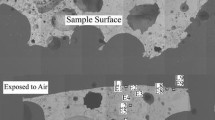Abstract
A simulated fingerprinting approach is demonstrated, aiming the discrimination of weapons-grade plutonium (WG-Pu) from different reactors. Light and heavy water and graphite moderated thermal reactors are considered, charged with fresh fuel assemblies of different enrichments. The plutonium isotopic composition is considered as the required characteristic fingerprints in the approach. Hence, plutonium isotopic ratios are used in 3D isotopic correlations for the discrimination purposes. The WG-Pu from the different reactors is well resolved between them. Within the light water moderated cases, the WG-Pu is resolved in groups according to their fresh fuel enrichment and the reactor and fuel assembly type. The fingerprinting approach is sensitive to a ‘Pu age’ beyond 0.5 years.





Similar content being viewed by others
References
Carson MJ, von Hippel F, Lyman E (2009) Explosive properties of reactor-grade plutonium. Sci Glob Secur 17:170–185
Chirayath SS, Osborn JM, Coles TM (2015) Trace fission product ratios for nuclear forensics attribution of weapons-grade plutonium from fast and thermal reactors. Sci Glob Secur 23:48–67
Fedchenko V (2014) The role of nuclear forensics in nuclear security. Strateg Anal 38:230–247
Jakopic R, Richter S, Kühn H, Benedik L, Pihlar B, Aregbe Y (2009) Isotope ratio measurements of pg-size plutonium samples using TIMS in combination with “multiple ion counting” and filament carburization. Int J Mass Spectrom 279(2–3):87–92
Kristo MJ, Tumey SJ (2013) The state of nuclear forensics. Nucl Instrum Methods Phys Res 294:656–661
Kristo MJ, Gaffney AM, Naomi Marks N, Knight K, Cassata WS, Hutcheon ID (2016) Nuclear forensic science: analysis of nuclear material out of regulatory control. Annu Rev Earth Planet Sci 44:555–579
Lantzos I, Kouvalaki Ch, Nikolaou G (2015) Plutonium fingerprinting in nuclear forensics of spent nuclear fuel. Prog Nuclear Energy 85:335–336
Nicolaou G, Koch L (1995) Identification of nuclear material with unknown irradiation history: a case study. In: Proceedings 17th annual ESARDA symposium on safeguards and nuclear material management, Aachen, Germany, 9–11 May 1995
Nicolaou G (2008) Provenance of unknown plutonium material. J Environ Radioact 99:1708–1710
Nicolaou G, Biegalski SR (2018) Discrimination of plutonium from thermal reactors in the frame of nuclear forensics. J Radioanal Nuclear Chem 317:559–564
ORNL/TM-2005/39 (2011) SCALE: a comprehensive modeling and simulation suite for nuclear safety analysis and design ORNL/TM-2005/39 Version 61 Oak Ridge National Laboratory Tennessee
Osborn JM, Kitcher ED, Burns JD, Folden CM, Chirayath SS (2018) Nuclear forensics methodology for reactor-type attribution of chemically separated plutonium. Nuclear Technol 201:1–10
Osborn JM, Glenon KJ, Kitcher ED, Burns JD, Folden CM, Chirayath SS (2018) Computational and experimental forensics characterisation of weapons-grade plutonium in a thermal neutron environment. Nuclear Eng Tehnol 50:820–828
Robel M, Kristo MJ (2008) Discrimination of source reactor type by multivariate statistical analysis of uranium and plutonium isotopic concentrations in unknown irradiated nuclear fuel material. J Env Radioact 99:1789–1799
Sendis M, Gauld I, Martinez JS, Alejano C, Bossant M, Boulanger D, Cabellos O, Chrapciak V, Cond J, Fast I, Gren M, Govers K, Gysemans M, Hannstein V, Havluj F, Hennebach M, Hondosy G, Ilias G, Kilger R, Mills R, Mountford D, Orlego P, Radulescu G, Rahimi M, Ranta-Aho A, Rantamaki K, Ruprecht B, Soppera N, Stuke M, Suyama K, Tittelbach S, Tore C, van Winckel S, Vasiliev A, Watanabe T, Toru Yamamoto, Toshihisa Yamamoto (2017) SFCOMPO-2.0: an OECD NEA database of spent nuclear fuel isotopic assays, reactor design specifications, and operating data. Ann Nuclear Energy 110:779–788
Varga Z, Nicholl A, Wallenius M, Mayer K (2016) Plutonium age dating (production date measurement) by inductively coupled plasma mass spectrometry. J Radioanal Nuclear Chem 307:1919–1926
Wallenius M, Peerani P, Koch L (2000) Origin determination of plutonium material in nuclear forensics. J Radioanal Nuclear Chem 246(2):317–321
Author information
Authors and Affiliations
Corresponding author
Additional information
Publisher's Note
Springer Nature remains neutral with regard to jurisdictional claims in published maps and institutional affiliations.
Rights and permissions
About this article
Cite this article
Nikolaou, G., Biegalski, S.R. Discrimination of weapons-grade plutonium from thermal reactors in nuclear forensics. J Radioanal Nucl Chem 322, 513–518 (2019). https://doi.org/10.1007/s10967-019-06810-4
Received:
Published:
Issue Date:
DOI: https://doi.org/10.1007/s10967-019-06810-4




